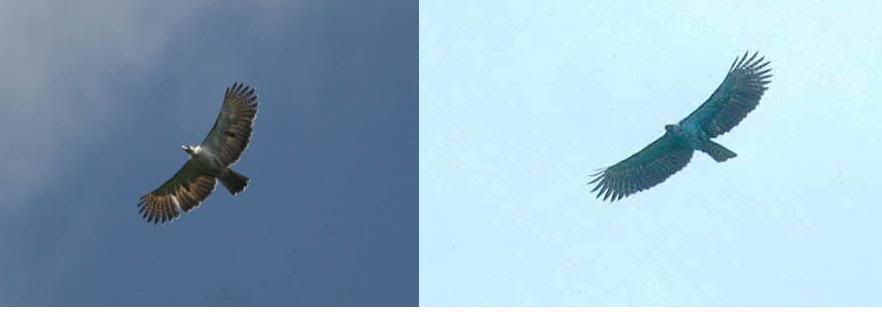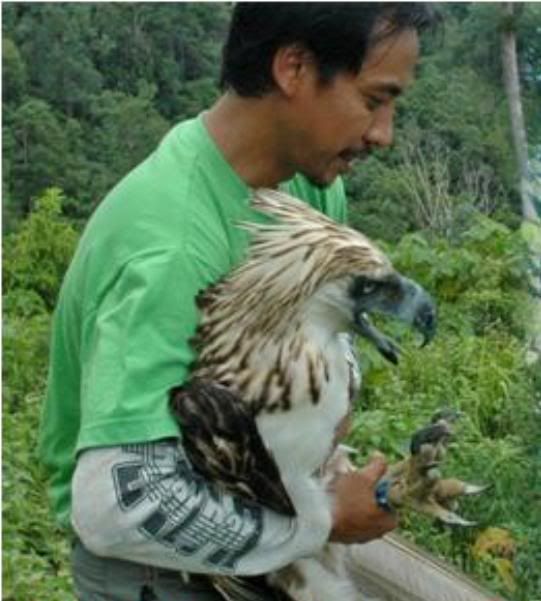Post by David on Feb 29, 2012 0:59:12 GMT -5
The great Philippine Eagle

Scientific classification
Kingdom: Animalia
Phylum: Chordata
Class: Aves
Order: Falconiformes
Family: Accipitridae
Genus: Pithecophaga
Species: P. jefferyi

Geographic Range
The Great philippine eagle or Philippine Monkey-eating eagle (Pithecophaga jefferyi) is endemic to the Philippines and is found on parts of the larger islands of Luzon, Samar, Leyte, and Mindanao. Also called “Haribon or Haring-ibon – meaning “Bird king”(Bueser et al., 2003; Delacour and Mayr, 1946; Ibanez et al., 2003)
Habitat Elevation
150 to 1450 m
Philippine eagles inhabit remnant patches of primary dipterocarp forest, a family of resinous trees that are found in the Old World tropics. Pithecophaga jefferyi also occurs in second growth and gallery forest.
Physical Description
Pithecophaga jefferyi is the world’s largest eagle species. Males and females are similar in appearance. They have a white belly and underwing, while the upperparts are a rich brown, with pale edged feathers. The long feathers of the head and nape form a distinctive crest and are dark-brown and cream on the margins. Chicks have white down, and juveniles are similar in appearance to adults but have white margins to the feathers on the back and upperwing. The heavy legs are yellow with large, powerful claws, and the large, high arched, deep bill and eyes are bluish-gray.

The average female is about 102-112 centimeters (40-44 inches) long and weighs about 7-8 kilograms (15.5-17.6 lb). The adult male is about 10 to 20% smaller and averages at about 91 centimeters (3 ft) and averaging 5 kilograms (11 lb). The Philippine Eagle is the world's largest living eagle in terms of length. The species has a wingspan of approximately 2 meters (6.7 ft). The wings of this eagle are shorter than large eagles of open country (such as the Martial Eagle, Wedge-tailed Eagle and Steller's Sea Eagle), but are quite broad and have a greater surface area than any other eagle.

Food Habits
Food habits vary from island to island depending on species availability, particularly in Luzon and Mindanao. This is due to the islands being in different faunal regions. For example, Philippine flying lemurs, the preferred prey in Mindanao, are absent in Luzon. The primary prey for the eagles seen in Luzon are monkeys, birds, flying foxes, giant cloud-rats Phloeomys pallidus which can weigh twice as much as flying lemurs (that is, 2 to 2.5 kg), and reptiles such as large snakes and lizards. The eagles prefer flying lemurs and Asian Palm Civets, but they occasionally eat small mammals, birds (owls and hornbills), reptiles (snakes and monitor lizards), and even other birds of prey. There have been reports of eagles capturing young pigs and small dogs. It is estimated that the flying lemur could make up 90% of the raptor's diet in some locations.

Eagle pairs sometimes hunt troops of monkey cooperatively, with one bird perching nearby to distract the primates allowing the other to swoop in unnoticed for the kill Philippine eagles feed mainly on medium-sized mammals, such as flying lemurs, palm civets, flying squirrels, and monkeys, giving them their other common name: 'monkey-eating eagle'. Other prey includes rats, snakes, small deer, birds, and bats.
Individuals hunt starting from their nest at the top of a hill and slowly move downhill from perch to perch before flying back up the hill upon reaching the bottom. They use this technique to conserve energy because they are able to soar from perch to perch while looking out for prey. Pairs have been observed hunting together; one individual acts as a decoy, drawing the attention of a group of monkeys towards it while its partner captures a monkey from behind.

Huge Beak with powerful legs, sharp large talons and claws
Reproduction
Breeding interval
Pithecophaga jefferyi breed once every two years.
Breeding season
Pithecophaga jefferyi mate from October to December.
Eggs per season
1 to 2; avg. 1
Time to hatching
60 days (average)
Time to fledging
7 to 8 weeks; avg. 7 weeks
Time to independence
5 months (average)
Age at sexual or reproductive maturity (female)
3 to 5 years; avg. 5 years
Age at sexual or reproductive maturity (male)
4 to 7 years; avg. 7 years

Pithecophaga jefferyi mate for life. When the partner dies, it is not unusual for the eagle to find a new mate. Four behaviors are associated with aerial displays of courtship behavior: mutual soaring, dive chase, talon presentation, and territorial flights. Mutual soaring is a circular gliding pattern by both birds where the male usually soars higher than the female. Dive chases are a diagonal drop in altitude with the wings half folded onto the body, with the male trailing behind the female. Talon presentation is characterized by a quick expansion of the talons toward the back of the female. The female may present her talons by flipping over and extending her talons. This mutual talon presentation is also seen in other raptor species. Territorial flight behaviors are gliding flights with the male slightly above the leading female.
Mating systems:
(Monogamous)
The natural breeding cycle requires two years. Successful partners have only one offspring every two years. The breeding season is from October to December in order for the chick to hatch during the dry season (February to May). The chick hatches after 60 days and becomes a fledging at 7 to 8 weeks. Independence is reached at 5 months. Females reach sexual maturity at 3 to 5 years and males reach maturity at 4 to 7 years.
The nest is normally located between 27 to 50 meters from the ground. Pairs build an enormous nest, anywhere from 1.2 x 1.2 m to 1.2 x 2.7 m, in the canopy of dipterocarp forests or on a large epiphytic fern. The nests are made out of decaying twigs and sticks piled on top of each other. The same nest is used from year to year.
Females incubate the egg for roughly two-thirds of the incubation time, males incubate the egg the remaining one-third. The chick is protected and fed by both of the parents for 7 to 8 weeks. The eaglet leaves the nest at 5 to 6 months.

Lifespan/Longevity
Pithecophaga jefferyi can live anywhere from 30 to 60 years. A captive Philippine eagle lived to 41 years old in a zoo in Rome. ("Philippine Eagle Foundation", 2004; "Species Info – Philippine Eagle. Red Book Data – Threatened Birds of Asia", 2003) The oldest living captive Philippine eagle is named “Thor” 43 years old at the Eagle center in Davao.